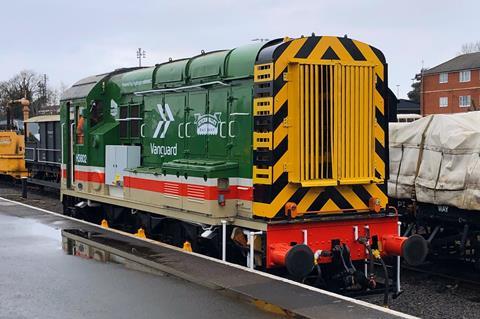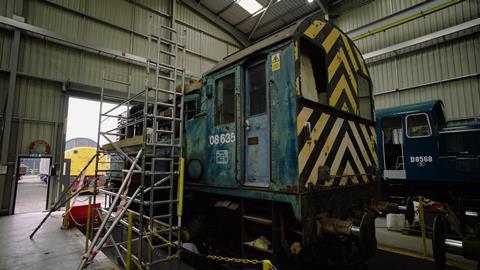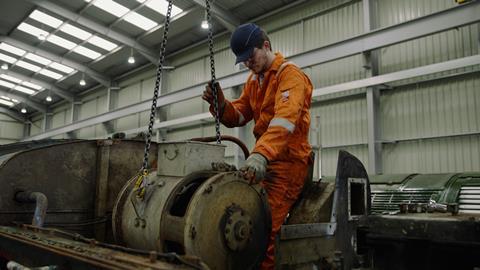
UK: Hydrogen technology specialist Vanguard Sustainable Transport Solutions unveiled its repowered Class 08 shunting locomotive at the Severn Valley Railway on January 31.
Initially, the former 08635 is operating in electric mode using lead-acid batteries charged from shore supply. This is an interim stage pending installation of an 80 kW fuel cell, which was on display indoors at the heritage railway’s Kidderminster station for guests to inspect. The loco itself made its first runs under electric power in the station sidings.
Vanguard STS has been working on the repowering project for more than four years. The company is a spin-out from the University of Birmingham, whose rail research institute BCRRE is one of the partners in the initiative.
Three-axle shunting locomotive 08635 was built at British Rail’s Derby works in 1959. Its diesel engine and generator are being replaced with a hybrid traction system designed by Vanguard at the company’s base in Birmingham, comprising hydrogen storage cylinders, a fuel cell stack and a battery to provide additional power when needed.
| HydroShunter demonstrator technical details | |
|---|---|
| Weight tonnes | 50 |
| Gauge mm | 1 435 |
| Tractive effort kW | 250 |
| Hydrogen fuel capacity kg | Up to 60 |
| Brakes | Dual (air and vacuum) |
| Maximum speed km/h | 24 |
| Estimated running time between refuelling h | 20 |
The modular onboard elements include hydrogen storage, the fuel cell and a traction battery which provides DC power to the traction motors. The batteries have now been mounted on a subframe fitted to the existing engine fixings, and the loco has retained its traction motors and controls. These are connected to an encoder which translates the commands into electrical signals for the control unit which in turn activates the battery cells.
Fuel cell product withdrawal

Vanguard’s Chief Engineer Charles Calvert described the HydroShunter as a ‘version zero’ test bed which will act as a proof of concept for a production run of fuel cell locos.
The repowering has faced a number of challenges, Calvert explained. This included a last-minute withdrawal of the fuel cell product originally purchased for the project. The revised 80 kW fuel cell supplied by Toyota and the 230 kWh battery module combine to offer a tractive effort of 250 kW and an estimated running time of 20 h, depending on the duty cycle. The fuel cell module is expected to be fitted to the loco in mid-March.
‘This is a product aimed at those operators who cannot have a shunter sat being recharged for hours’, said Vanguard Chief Executive Rob Gibson. He believes there is a clear market in the industrial loco and freight terminal management sectors for a truly zero-emission locomotive that needs to be in continual use; this could make the fuel cell option more attractive than either a battery-electric loco or a diesel-battery hybrid.
Innovation partnership

Gibson and Severn Valley Railway Managing Director Gus Dunster both highlighted the importance of the HydroShunter project in developing skills both among the heritage railway’s staff and volunteers and among younger staff within the rail industry.
‘We do not see ourselves as purely a heritage operation’, Dunster said, noting that SVR was the only preserved line in the UK to have a formal partnership relationship with Network Rail.
Having been set up with technology from the University of Birmingham five years ago, Vanguard STS worked on the HydroFlex conversion of an ex-British Rail Class 319 EMU to run on hydrogen power. Gibson said the company has been working ‘rather under the radar’ and was now seeking to increase its profile.
As well as undertaking retractioning work, the company is aiming to offer hydrogen and battery powertrain design, refuelling and safety case protocol services, as well as onsite and remote hydrogen generation.
The company also has an operation in Croatia working on the development of fuel cell trainsets with a local supplier.



